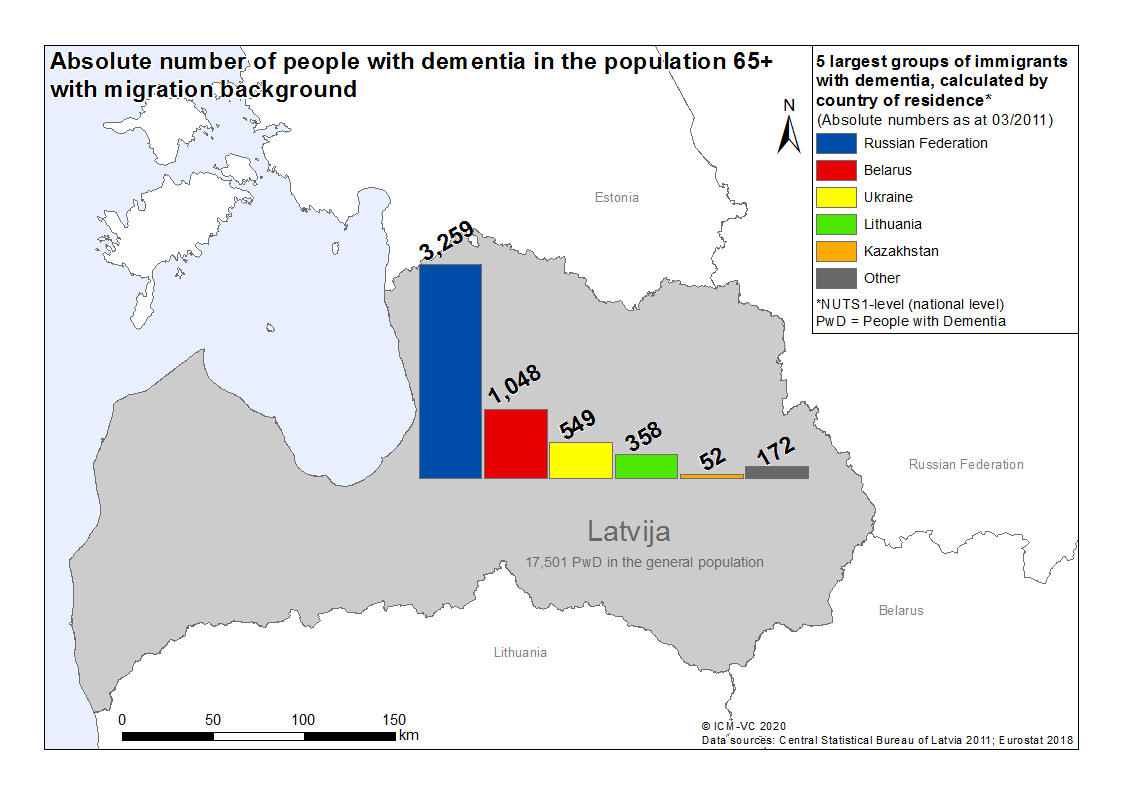EU-Atlas: Dementia & Migration
| Largest group | 2. largest group | 3. largest group | 4. largest group | 5. largest group | |
| Absolute numbers | |||||
| PwMD per 100,000 inhabitants 65+ |
| Absolute numbers | PwMD per 100,000 inhabitants 65+ | |
| Largest group | ||
| 2. largest group | ||
| 3. largest group | ||
| 4. largest group | ||
| 5. largest group |
| Prevalence per 100,000 inhabitants 65+*, calculated by country of residence | |||
|---|---|---|---|
| high > PwMD |
minor > - PwMD |
||
| increased > - PwMD |
low ≤ PwMD | ||
| medium > - PwMD |
|||
| PwMD = People with a Migration background with Dementia *Bulgarien, Litauen, Malta, Polen in der Bevölkerung 60+ |
|||
| Absolute number of PwMD 65+ | |
| PwMD per 100,000 inhabitants 65+ |
Latvia
Latvia’s migration history is characterized by waves of large-scale immigration and emigration (especially to and from the Russian Federation)1. Between the Second World War and the collapse of the Soviet Union in 1990/1991, immigration of people from the Russian Federation predominated2,3. After 1990 and especially following EU accession in 2004, emigration has increased significantly and Latvia has developed from an immigration country to an emigration country3. Between 1990 and 2019, the migrant population (born abroad) and the proportion of migrants in the total population decreased (646,000 to 237,300; 24.2 to 12.4%)4. However, as of 2016, a large number of people originating in the Russian Federation still live in Latvia (about a quarter of the population)1. There are also small populations of people from Belarus, Ukraine, Poland, and Lithuania5.
In Latvia, about 118,200 people with a migration background are aged 65 or older. Of those, approx. 5,400 are estimated to exhibit some form of dementia. Calculations show the most affected migrant groups presumably originate from the Russian Federation (approx. 3,300), Belarus (approx. 1,100), Ukraine (approx. 600), Lithuania (approx. 400), and Kazakhstan (approx. 50)6.
Although no national dementia plan could be identified for Latvia, a ‘Clinical Guideline for Alzheimer's Disease, Vascular Dementia, Lewy-Body Dementia, and Frontotemporal Dementia’ was published in 2017. This document has 162 pages and covers topics such as the etiology, clinical picture, diagnosis, prevention, and treatment of the most common forms of dementia. In none of these topics is a migration-related issue addressed7.
References
- Minority Rights Group International: Latvia: Russians [https://minorityrights.org/minorities/russians-4/] (2018). Accessed 22 Apr 2020.
- Rozenberga IG, Zirnite M: Oral History: Migration and local Identities. In: Conference at the University of Latvia. Riga; 2008.
- SPLASH-db.eu: Policy: "Migration Policies: Latvia"; 2015.
- International Organisation for Migration: International migrant stock as a percentage of population at mid-year 2019: Latvia; 2019.
- Smogorzewski KM, Stranga A, Misiunas RJ, Bater JH, Spekke A, Gulyans PV: Latvia. In: Britannica. 2020.
- Central Statistical Bureau of Latvia: Population and Housing Census 2011. In. Rīga: Central Statistical Bureau of Latvia 2011.
- Latvian Association of Neurodegenerative Diseases: Alcheimera slimības, vaskulāras demences, Levi ķermenīšu demences un frontotemporālās demences klīniskās vadlīnijas. In. Riga; 2017.


![[Translate to Englisch:] Logo RBS [Translate to Englisch:] Logo RBS](/fileadmin/_processed_/9/7/csm_RBS_Logo_RGB_0e245a98a4.jpeg)